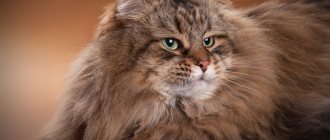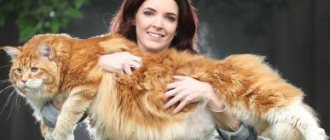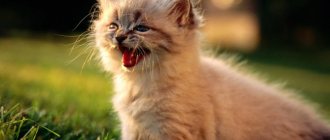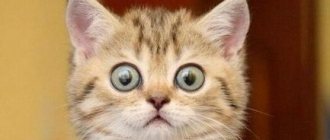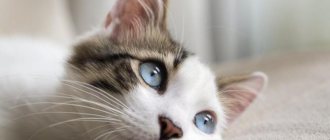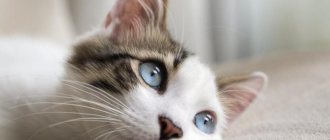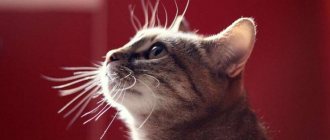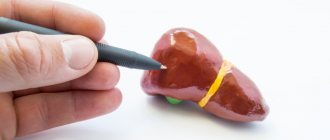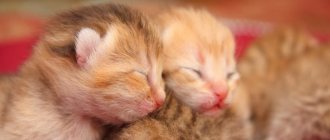The mustachioed pets captivated the ancient Egyptians with their grace and majesty, so they were revered for a long time on a par with the gods. But even now, people continue to clean out cat litter boxes and feed their pets at 6 am if they refuse to eat alone. In addition to love, the level of responsibility also increases.
The modern owner knows much more about the body of his cat than the inhabitants of Ancient Egypt, but is constantly learning something new. And this is not surprising! Some facts about anatomy are not only useful, but also so stunning that they are definitely worth sharing with your friends.
Skeleton and its parts
What a cat's body consists of can be found out through anatomy - a branch of biology that studies the structure of the body. First, you should get acquainted with the frame that holds all the important organs, that is, with the skeleton.
There are about 40 more bones in the cat skeleton than in the human skeleton, amounting to 244-250 pieces. The exact number depends on the length of the tail.
Skull and teeth
The cat's skull has 24 bones. 13 of them are on the facial part, and 11 are on the cranial part. Compared to other mammals, a cat's head is quite small in relation to its body, but it has a well-developed brain inside its skull.
The strong jaws of mustachioed pets have 30 sharp teeth. A smaller number (26) is typical only for kittens. By 7-8 months, their milk teeth are replaced by molars, and the dentition is replenished with missing molars.
Spine and tail
A cat's flexibility is due to the amazing mobility of its vertebrae. They can all be divided into 5 departments:
- cervical, consisting of the most massive bones;
- thoracic, to which 8 pairs of ribs are attached;
- lumbar, surrounded by muscles that hold the contents of the abdominal cavity;
- sacral, consisting of 3 fused vertebrae;
- caudal, including from 12 to 28 vertebrae.
Thanks to the massiveness of the cervical vertebrae, the animal can easily turn its head almost 180°, and thanks to its underdeveloped collarbones, it can easily penetrate the narrowest crevices.
The tail plays a special role. With its help, the cat maintains balance while jumping or falling from a height.
Four paws, and there are scratches on them
A cat's paw bones are not directly attached to the skeleton. They are held in place by muscles and tendons.
The hind limbs differ from the front limbs in being longer and having fewer fingers. There are as many of them in front as there are in humans, and in the back there are only 4.
Each of the fingers is equipped with a sharp claw. In a calm state, the claws are retracted into a special pouch, but when you press on the pad, they can be returned back. This is very convenient when trimming overgrown claws.
Due to the unusual location of the knee (right under the belly), cats always walk on tiptoe. This bizarre method of transportation is not only silent, but also very safe. When jumping, the paws absorb all the energy expended, so landing from a great height is soft and quiet.
Respiratory system
Breathing provides the body with oxygen and also gets rid of excess water.
The cat's respiratory system is similar to most mammals.
Respiratory organs include:
- Nose. The inhaled air enters the nasal cavity, where mucus is contained, which traps small dust particles, hairs and bacteria and prevents them from penetrating into the lungs.
The nose traps inhaled dust particles, hairs and bacteria
The very process of a cat's breathing can be described as follows: under the action of the pectoral muscles and diaphragm, the lungs expand and pull air through the nasal cavity into the respiratory tract until it reaches the alveoli, which come into contact with the blood vessels and saturate them with oxygen, while at the same time removing carbon dioxide from them.
Cat anatomy: structure of internal organs
The anatomical structure of a cat is close to humans and other mammals. Despite this, each animal has its own characteristics that distinguish it from other species.
Heart, blood and vessels
The heart is responsible for saturating cells with oxygen. This important muscle consists of 4 sections: 2 atria and 2 ventricles. On average, the heart rate is 130-140 beats per minute.
Calculating your pet's pulse is quite simple. To do this, you need to find the artery on the inside of the thigh.
The circulatory system includes 3 types of vessels:
- arteries saturated with oxygen;
- veins that carry carbon dioxide;
- capillaries that regulate metabolism and deliver blood directly to the organs.
The composition of any blood includes plasma and blood cells (platelets, erythrocytes, leukocytes). The uniqueness of cat blood lies in the fact that it is divided into only 3 groups: A, B and AB. They are taken into account when diluting and transfusing, since not all of them are compatible with each other.
The nervous system and its “ruler” – the brain
The nervous system regulates the animal's behavior. It consists of 2 departments:
- Central
. Includes the brain stem, spinal cord and brain. Responsible for reflexes (breathing, swallowing) that arise as a result of reactions to internal and external stimuli.
- Peripheral
. Includes cranial and spinal nerves. Connects the central nervous system with the organs of the body and is responsible for conducting nerve impulses. Thanks to the work of this department, conscious actions are carried out: releasing claws, licking and moving in space.
Each part of the brain performs a specific function. The occipital lobe is responsible for vision and touch, the olfactory bulb is responsible for smell perception, and the temporal lobe is responsible for memory.
The gastrointestinal tract is the main system, according to the cats themselves
The digestion process begins immediately after swallowing food. In the mouth, pieces of eaten food are softened by saliva and teeth. This makes it easier for them to pass through the pharynx and esophagus.
The environment in a cat's stomach is more acidic than a human's, so it easily processes the coarse fibers of raw meat. Problems arise only with carbohydrates, so your furry pet’s diet should not contain a lot of cereals.
Products broken down into water, proteins, fats and carbohydrates move to the duodenum and small intestine. Some of the nutrients are absorbed into their walls, and unprocessed residues are compacted into the feces and exited through the rectum.
Breathe and purr
The cat's body is supplied with oxygen through the respiratory system. It includes:
- nasal cavity, which cleans the inhaled air of dust and bacteria;
- pharynx, which provides additional filtration, warming and humidification of the air;
- the larynx, which regulates the volume of incoming oxygen and protects the trachea from food ingress;
- trachea - a special tube that regulates the flow of oxygen and the removal of carbon dioxide;
- the lungs are the main respiratory organ responsible for the process of gas exchange;
- the diaphragm, which controls the process of contraction and expansion of the lungs.
Whiskered pets breathe more frequently than humans and dogs. At rest, they take 20-30 breaths per minute.
In addition to the respiratory function, the larynx is responsible for the production of sounds. Thanks to her, animals meow.
With purring everything is more complicated. The mechanism of its appearance is explained by several theories, but most scientists are inclined to vibration of the hyoid bones.
How is a cat different from a cat?
The internal structure of a cat and a female cat are largely the same, but their genitals are different from each other. The male reproductive system consists of:
- testes;
- vas deferens;
- prostate;
- scrotum;
- penis.
The testes are responsible for the production of testosterone and sperm maturation. Through the ducts, sperm enters the penis and exits, allowing you to conceive offspring. With age, its quality deteriorates, but only castration can stop its production.
Bearing kittens is carried out exclusively by females, whose reproductive system is represented by:
- bicornuate uterus;
- cervix;
- vagina;
- ovaries;
- fallopian tubes;
- vulva.
The ovaries are an analogue of the testes. They are responsible for the production of female hormones and the maturation of eggs. Fertilization is possible only during estrus, so the most effective way to protect against unwanted pregnancy is timely sterilization.
Cats also go to the toilet...
The cat's urinary system consists of 4 organs: the urethra, bladder, ureters and kidneys. Urine enters the urethra only after careful filtration in all other sections. At the exit, it becomes secondary, as it loses some of its impurities.
Cats go to the toilet 2-3 times a day. The color of their urine is light yellow, and any change in shade indicates pathology. Due to the narrow urethra, males often suffer from blockage of the urethra by hard formations. As a result of injury to the walls of the bladder, the shade of urine changes to bright orange, brown or red.
Rehabilitation period
How long the recovery phase will last depends on the severity of the fracture, the general condition and age of the cat. In young individuals, it usually lasts three weeks, with a maximum of 30 days. In an old cat, the healing process is longer - 35-40 days.
To monitor proper fusion of the bone structure, your pet should be taken to a veterinary surgeon for a monthly check-up.
To restore the motor function of the damaged limb, elasticity and muscle tone, manual massage should be performed, the technique of which will be introduced by a veterinarian. Daily massage procedures stimulate blood circulation, healing of surrounding tissues and accelerate the process of bone fusion.
A cat's diet should be balanced, nutritious and easily digestible. The animal needs foods enriched with phosphorus and calcium. However, we must remember that an excess of these components often leads to the formation of stones in the gall bladder and kidneys.
Vitamin and mineral supplements will also help speed up your pet's recovery, but they can only be given after consultation with a specialist. The veterinarian prescribes vitamins taking into account the needs of the animal.
What shapes an animal's appearance
Having figured out what the cat’s skeleton and its internal organs are made of, you can consider the external features and sensory organs. Unlike dogs, the appearance of these cats is practically no different from their wild counterparts. Exceptions include only decorative species obtained artificially.
Strong muscles
A cat's body has 517 muscles, which is 133 less than a human's. Despite this, the muscular system is very elastic. That is why mustachioed pets easily curl up into a ball and take other bizarre poses, surprising their owners with their flexibility.
Cat muscles are divided into 2 types:
- striated
, regulating the mobility of body parts and controlled by the central part of the nervous system;
- smooth
, controlling the functioning of the gastrointestinal tract, respiratory system and all internal organs with the help of impulses received from the peripheral nervous system.
Each muscle consists of 3 sections. The first ones are responsible for jumping over long distances, the second ones for running short distances, and the third ones for soft and quiet sneaking up during the hunt.
Beautiful skin
The skin covers the entire body of the animal, protecting it from temperature changes, germs and injuries. It consists of 2 layers:
- epidermis
, formed as a result of cell death and keratinization;
- dermis
containing capillaries, sebaceous glands and hair follicles.
The constant desire to rub against a person and surrounding objects is explained by the release of a specific secretion with which the cat marks its territory. It is formed from the sebaceous glands on the face, between the fingers and in the anus area.
The coat consists of undercoat and guard hairs. Each hair is capable of reflecting light, giving the coat a beautiful shine. That is why the appearance of dullness is a symptom of internal pathologies.
Thanks to the erector muscle, the hairs of a mustachioed pet can stand on end. The characteristic stripe on the back and fluffy tail can be seen in moments of fright or extreme cold.
Whiskers, paws and tail like cat documents
Differences can be seen not only in animals of different sexes, but also in animals of different breeds. The British cat's body parts are not similar to the Siamese's body parts. In the first case, the pet will be more massive and densely built, and in the second, thin and graceful.
Belonging to a particular breed is determined by the shape of the ears, the shape of the eyes, the length of the tails and paws, as well as the color of the coat and even its presence. Only short-haired breeds are divided into 3 large groups: American, European and Oriental. But there are also long-haired and bald ones.
There is even a separate classification based on body type. Thanks to such diversity, you can easily choose a pet based on your preferences and capabilities.
What causes profuse sweating?
Excessive sweating is not typical for cats, so if this symptom appears, the owner should be wary. It can be a sign of both exposure to unfavorable factors and pathological conditions.
Diseases
When an owner notices that their pet is leaving wet marks more than usual, this may be a warning sign for them. Excessive sweating in your pet can be a symptom of various diseases. First of all, those associated with increased temperature:
- hemobartonellosis - an infectious bacterial disease that affects blood cells;
- feline AIDS, a viral disease that suppresses the immune system;
- viral leukemia - a disease associated with suppression of bone marrow functions;
- flu;
- infectious peritonitis, a fatal infection that attacks the immune system of cats;
- upper respiratory tract infections;
- panleukopenia - “distemper”, a viral disease that affects many systems of the cat’s body;
- toxoplasmosis is an infection caused by microscopic parasites.
Naturally, each of these pathologies is accompanied by a number of other symptoms. However, primary signs, which include profuse sweating, are prerequisites for urgent contact with a veterinarian.
Stress
In addition to illness, excessive sweating can cause stress. Most often, this condition is provoked by factors that irritate the nervous system, causing changes in the functioning of organs.
Stress can be short-term or it can last for a long time. Short-term stress most often passes painlessly. If an animal is stressed for a long time, then a malfunction of some system (for example, a thermoregulation system) or a disease occurs.
Causes of stress can be:
- physical damage, such as burns or injuries;
An injury to a cat is a stressful situation for it, especially if it is accompanied by long-term treatment.
Overheat
As the weather gets hotter, many cats may suffer from overheating. This condition may result in dysfunction of thermoregulation. A cat's body temperature can rise to 41 degrees. Signs of pathology are always clearly expressed. Prolonged overheating can be fatal. Those most susceptible to heat stroke are:
- kittens;
- pregnant cats;
- older animals.
These categories of animals are at risk because their bodies are weakened due to age or physiology. Also at risk are cats whose breed suggests a brachycephalic skull structure. In cats with a shortened muzzle, heat exchange processes are worse. This becomes a reason to pay closer attention to pets during the heat.
Cats with very long hair or thick undercoat are also at greater risk of heatstroke than others. Signs of overheating include:
- unnatural spread-eagled pose;
- breathing through the mouth with the tongue sticking out;
A cat breathing with its mouth open is a sign that the animal is overheating.
I first observed overheating of an animal in my Thai cat. We lived in an apartment, but often went for walks together; she walked perfectly on a harness and even without it, not lagging behind me more than 4-5 steps. Not far from the house there was a forest and a meadow. And then one autumn (Indian summer) we went for a walk. The sun was shining and the weather was beautiful. About twenty minutes later, the cat began to leave the path and lie down in the thickets of grass on its side. I chalked it up to being tired; after all, we didn’t go for walks every day, and at home the animal had virtually no conditions for physical exercise. I gave her a few minutes of breathing space and then moved on. My “faithful dog” got up and followed me. And then I saw that the cat opened its mouth, stuck out its tongue and began to breathe heavily. I didn’t know how dangerous this condition was, but out of compassion for the animal, the walk ended there; the pet got home in my arms. Only later did I find out. that a cat's breathing is a sure sign of overheating, not fatigue.
Navigating in space
Finally, it is worth mentioning what a cat’s sense organs are made of. This includes not only the eyes, ears and nose, but also the tongue and whiskers.
The vision of a genius
Whiskered pets see perfectly in the dark, distinguish 3 colors (red, blue, green) and as many as 25 shades of gray. The mysterious glow of their huge eyes at night is explained by the tapetum - a special vascular layer located behind the retina.
Thanks to the convex cornea, the viewing angle of these animals is almost 270°, so with the help of their necks they are able to assess the situation at all 360°.
Whiskers
The tactile function is performed by vibrissae, that is, cat whiskers. In fact, they also belong to hairs, but their follicles lie much deeper than the guard coat and undercoat. They actively interact with nerve impulses, determining the surrounding temperature, perceiving signals of pain and pleasant touches.
These tactile hairs are found not only on the face, but also on the hind legs. Because of this, mustachioed pets actively shake them when they step in the mud or enter the water.
Pulling or cutting mustaches is strictly prohibited. In addition to acute pain, the animal may permanently lose its tactile function, which will affect orientation in space and mental health.
Nose-sniffer
The cat's nose contains 80 million olfactory receptors, so its sensitivity is 2 times higher than that of humans. Additionally, the Jacobson's organ, a small tube located on the upper palate, is responsible for the perception of odors.
Another interesting fact is that the imprint of a wet cat’s nose, like the pads of human fingers, is unique. Thanks to this, it can easily be classified as biometric data.
Ears-on-top
The developed hearing of furry pets even detects ultrasound. Its ears, consisting of an outer, middle and inner part, are responsible for this. The task of the first is to collect sound, the second is to transmit a sound signal, and the third is to convert sound vibrations into nerve impulses.
Thanks to this feature, animals moving to the dacha in the summer can easily find their way back during their walks. Having moved away 3 km, they perfectly hear the voices of their owners and other sounds associated with a country house.
Tongue - lover of food
Despite night vision, an excellent sense of smell and acute hearing, cats are inferior to us in some ways. The tongue has only 473 taste buds, while the human tongue has as many as 9,000.
Whiskered pets are good at distinguishing sour, salty and bitter foods, but almost unable to detect sweet ones. The love for ice cream is explained by its similarity to milk, familiar from childhood. For this reason, treats should be avoided as animals become lactose intolerant as adults.
Separately, it is worth noting 2 special receptors that are not typical for humans. One recognizes the taste of umami, that is, monosodium glutamate, and the second recognizes the taste of water. This is why cats often steal sausages and have a special love for unstagnant tap water.
How to deal with a cat scratching furniture and wallpaper
Declawing a cat is not an option. The consequences of such an operation do not at all justify the damage to your favorite furniture and repairs. If you care about your pet, choose one or several of the alternatives suggested below.
scratching post
Love for a scratching post does not appear immediately. Many pets are more delighted only by the packaging box, but thanks to the due persistence of the owners, over time they get used to its contents.
In addition to regular training and timely encouragement to sharpen claws in the right place, it is necessary to take into account the wishes of the animal itself. Not everyone likes standard vertical surfaces in the form of a column and a play complex, so don’t rush to give up until you’ve tried all the possible options.
Manicure
The easiest option is to trim the cat's claws. If you follow the basic recommendations, this procedure is not dangerous and painless.
Anti-scratch
Anti-scratch caps are soft vinyl or silicone caps that are placed on the claws and replaced as they grow. Despite the convenience, this product has several disadvantages.
Under the caps, a secretion produced by the glands on the fingertips accumulates, which is fraught with inflammation. Also, some overly active cats tear off the “anti-scratch” with their teeth and swallow them.
Causes of injury
A restless cat can easily damage its paw, because one incorrectly calculated jump or failed maneuver can provoke a dislocation.
Experts divide dislocations into 2 categories:
- Congenital.
- Acquired, that is, received due to injury.
Congenital dislocation occurs if the animal’s joint structure is naturally formed incorrectly; in veterinary medicine, the pathology in question, which manifests itself in kittens after 6 months, is called “dysplasia.” Most often, this disease occurs in Himalayan or Persian breeds.
Acquired injury may occur for the following reasons:
- A chronic pathology that gradually develops in an animal’s body, for example, osteoporosis or rickets, as it develops, destroys both bone and joint tissue, which can become the cause of the injury in question.
- As we noted earlier, improper handling of kittens, in particular play in which the animal is pulled by the paws, causes dislocation of both the front and back paws.
- An incorrectly calculated jump, a strong blow against any obstacle, competition with one’s relatives - all of the above actions can cause injury.
To summarize, it’s time to note that a pet’s paw can be injured almost everywhere, and only the owner can help the purr solve this problem by showing his care and love in a timely manner.
Alternative to a haircut: is there one?
Most veterinary clinics offer the procedure - onychectomy, but how humane it is has long been discussed and condemned not only by doctors, but also by breeders who previously agreed to perform the operation on a cat. Onychectomy is nicely called “soft paws”, but in reality it is a complex, bloody and unreasonably difficult psychological procedure.
The second most popular are anti-scratch silicone tips of different colors. They are attached with special glue. A cat's manicure looks glamorous; the animal stops sharpening its claws on furniture, but this greatly affects their ability to climb and walk. In addition, multi-colored caps do not eliminate the problem - the claws underneath them still grow and need to be trimmed periodically.
Specialists of the RosVet VC do not approve of onychectomy as a whim of the owner. The operation is possible only according to indications, when there is severe injury to the fingers and it is impossible to save the phalanx. Caps are a less dangerous method, but also suppress the cat's natural instincts. The solution is to provide your pet with a place to grind down its claws or regularly visit the veterinary clinic to have its claws trimmed. You can sign up for the procedure by phone: + 7 (495) 256-11-11, around the clock.
How many pads do cats have on their front paws? How many toes does a cat have on its hind and front paws?
Typically, a cat has 18 toes on 4 paws. These are established norms, but like humans, animals are born with abnormalities.
Physiological characteristics of cat paws
Cats have different numbers of toes on their hind and front paws. There are four of them at the back and they are placed on the same line. There are five on the front ones, one of the fingers is higher than the others, and does not touch the floor, set slightly to the side. The cat needs it when moving on inclined or vertical surfaces.
Each finger ends in a claw. In a calm state, it is hidden inside a leather trench, for example, when walking, in order to move silently. And if necessary, the animal releases it outside (for protection, attack).
Cats' claws are curved and sharp.
Polydactyl cats
Due to genetic mutations, there are cats with anatomical abnormalities. There are 2 types:
- Polydactyly (more fingers) - does not interfere with the animal, but does not provide any advantages. True, for this they must be correctly formed.
- Hypodactyly (absence of one or more fingers) - an anomaly can cause various pathologies leading to death (liver atrophy).
Finger functions
Toes are especially important for cats, as they perform functions such as jumping and silent movement. In addition, with their help, animals feel the texture of the surface and maintain balance. All this is possible thanks to the huge number of nerve endings located in the pads.
The receptors help cats detect subtle vibrations, which affects their ability to seek out prey such as mice.
This increased sensitivity also has a downside. Cats react acutely to changes in temperature and pressure. When the pads are damaged, they experience severe pain, so they can become irritable and aggressive. Cat owners should examine their pets' paws every day, this will help prevent health problems, and if wounds or other damage are found, provide assistance.
Mr. Cat recommends: interesting facts
Cats with anomalies were often encountered in the past, and notes were made about them:
- In the Middle Ages in the northeastern United States, pathology was not a rare occurrence. However, due to the witch hunt, all cats with this feature were destroyed.
- Ernest Hemingway kept more than 50 polydactyl pets in his house, so very often animals with this anomaly are called Hemingway cats.
- Slipper, a cat with a similar anomaly, also lived in the White House and belonged to President Roosevelt.
- The most common polydactyl cats are Maine Coons (approximately 40%). According to legend, this is due to the fact that in this way they could fish and move on the snow.
- The largest number of toes found in the world is 32 on 4 paws.
- The first studies were carried out in 1974.
- More often, deviations affect the forelimbs. The extra toes are located separately and do not interfere with cats when walking.
- A genetic mutation is a feature that does not determine the number of possible digits a kitten has. But if at least one of the parents has this anomaly, the autosomal gene will certainly cause polydactyly in the cub.
The principle of dermatitis
Dermatitis occurs for various reasons:
- thermal reasons. This disease occurs when a cat's skin comes into contact with a hot object or liquid. Prolonged exposure to sun rays or low temperatures on areas of the body can also lead to thermal dermatitis;
- parasitic causes - bites of fleas, ticks, lice eaters. The saliva released when bitten by such an insect causes severe itching. In addition, these parasites constantly shed scales, hairs, and secrete waste products - all this causes a rash and skin irritation. This type of inflammation usually appears behind the ears and in the tail area;
If an animal is bitten by an ixodid tick, then swelling occurs at this site. A tick bite causes skin itching and inflammation. Then a bald spot and a rash forms. Subcutaneous parasites cause extensive rashes and blisters. If a cat's ears are affected, then dermatitis manifests itself in the form of redness and rash in the ears. Helminths provoke dermatitis by entering the animal’s body and multiplying in its intestines. They release toxic substances and waste products. In the presence of parasitic dermatitis, the cat literally tears its skin with its paws and teeth, trying to get rid of severe itching. By scratching wounds, an animal can introduce an infection there.
irritants. Due to its increased sensitivity, a cat can react to contact with an external irritant. For example, domestic cats react to new shampoo, cleaning chemicals, and new items in the apartment. Dermatitis of the oral mucosa is possible after a pet comes into contact with poisonous house plants.
When the animal's immunity decreases, dermatitis occurs as a reaction to bacteria or fungus that could live on the cat's skin for a long time before. A favorable environment for fungal growth is warmth and humidity. Therefore, most often it occurs in the folds, in the armpits, on the chin, between the fingers, in the groin and tail.
Important! Flat-faced Persian cats are most susceptible to bacterial dermatitis. They usually develop fungus in the nose area
Such dermatitis usually does not have an obvious form, sometimes becoming more pronounced, sometimes going into hibernation.
